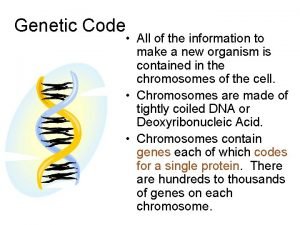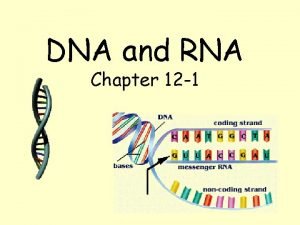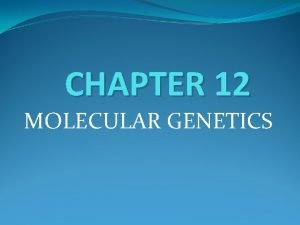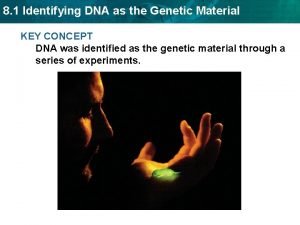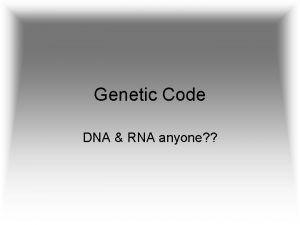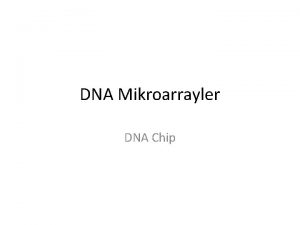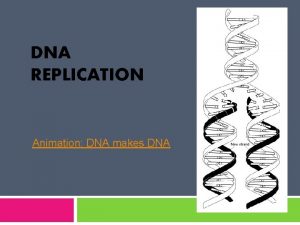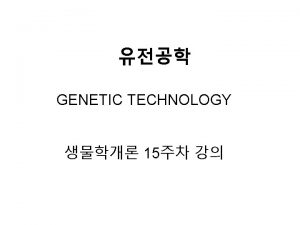DNA and the Genetic Code The Genetic Code
















- Slides: 16

DNA and the Genetic Code

The Genetic Code • A gene is a set of instructions for assembling a protein. • Proteins have a role in creating all the traits of an individual organism; they are part of every cell process, they make hair or skin a certain color, they can stimulate the body to make longer bones, and they can make it possible for your eyes to distinguish between red and green.


The Genetic Code • By carrying a code for assembling proteins, genes determine traits.

DNA • Genes are made of a substance called deoxyribonucleic acid (DNA). • The way DNA is put together forms a code that is ‘read’ by parts of the cell. • A DNA molecule is shaped like a long ladder twisted into a spiral.

DNA • There are 4 different nitrogen pairs that make up the ‘rungs’ of the ladder; adenine (A), guanine (G), cytosine (C), and thymine (T) • A always pairs with T, and G always pairs with C.


DNA • DNA copies itself with a process called replication. • During replication, the DNA molecule ‘unzips’ and adds new base pairs that are in the cytoplasm.


Mutations • A mutation is a change in the DNA or chromosome. • Mutations occur in body cells and sex cells, but only mutations in sex cells are passed to the offspring.

Mutations • Most mutations are not harmful. Although some can cause diseases, cancer or birth defects.

Chemical Mutagens • Substances and conditions that can cause mutations are called mutagens. • Some mutagens are found in pesticides, chemical wastes from factories, and cigarettes.

Chemical Mutagens • Different types of radiation can increase the rate of mutations. • Prolonged exposure to high doses of mutagens cause genetic changes that may result in cancer.

Inherited Disorders • Most inherited disorders are caused by recessive genes. • Cystic fibrosis causes the lungs to produce a thick mucus that clogs airways and promotes the growth of bacteria.

Inherited Disorders • The gene that causes cystic fibrosis is located on chromosome 7 • Sickle cell anemia causes the red blood cells to stiffen and become an odd shape. These abnormal cells are not able to carry as much oxygen as normal RBC’s.

Inherited Disorders Disorder Description Cause Albinism Inability to produce pigment in some or all organs, resulting in abnormally light skin, hair, and eye color Recessive Gene Achondroplasia (form of dwarfism) Condition in which person is far below normal size and lacks ability to grow normally Dominant Gene Huntington’s Disease Progressive loss of muscle control and mental abilities, starting from about age 35 to 45 Dominant Gene Phenylketonuria (PKU) Mental retardation (unless treated in infancy) resulting from a buildup of phenylalanine, an amino acid in proteins Recessive gene Tay-Sachs Disease Brain cells do not function normally resulting in progressive loss of motor skills and mental abilities, blindness and seizures; babies born with Tay-Sachs disease live only for a few years Recessive Gene
 Trace the code genetic code table
Trace the code genetic code table Genetic drift vs flow
Genetic drift vs flow Genetic programming vs genetic algorithm
Genetic programming vs genetic algorithm Genetic programming vs genetic algorithm
Genetic programming vs genetic algorithm A gene pool consists of
A gene pool consists of Gene flow vs genetic drift
Gene flow vs genetic drift Coding dna and non coding dna
Coding dna and non coding dna Molecular genetics section 1 dna the genetic material
Molecular genetics section 1 dna the genetic material Chapter 12 section 1: dna: the genetic material
Chapter 12 section 1: dna: the genetic material Chapter 12 molecular genetics
Chapter 12 molecular genetics Chapter 12 dna and rna section 12-1
Chapter 12 dna and rna section 12-1 Section 12-1 dna
Section 12-1 dna Section 1 identifying dna as the genetic material
Section 1 identifying dna as the genetic material Dna polymerase function in dna replication
Dna polymerase function in dna replication Bioflix activity dna replication dna replication diagram
Bioflix activity dna replication dna replication diagram What role does dna polymerase play in copying dna?
What role does dna polymerase play in copying dna? Dna and genes chapter 11
Dna and genes chapter 11
